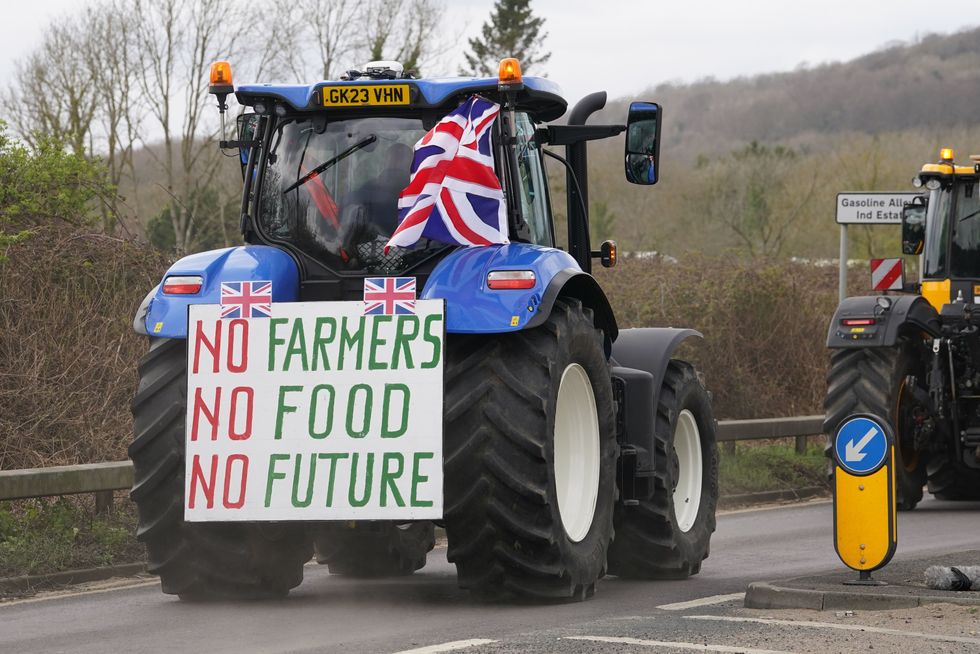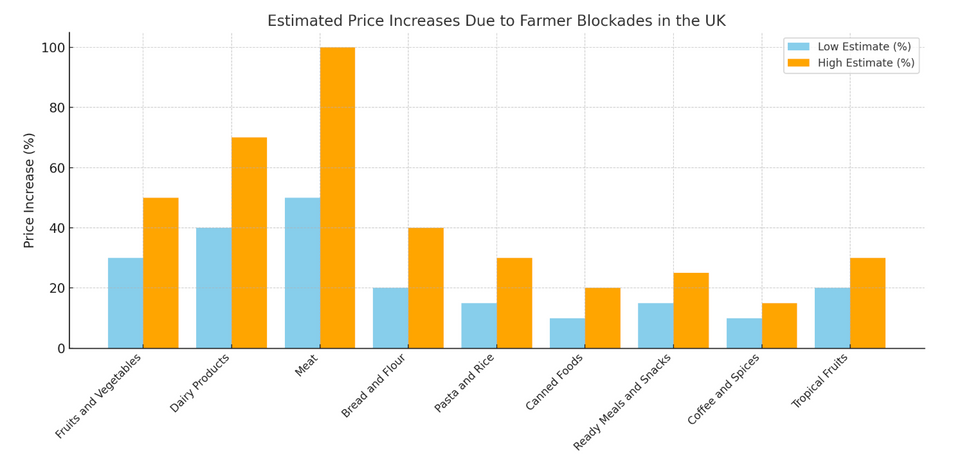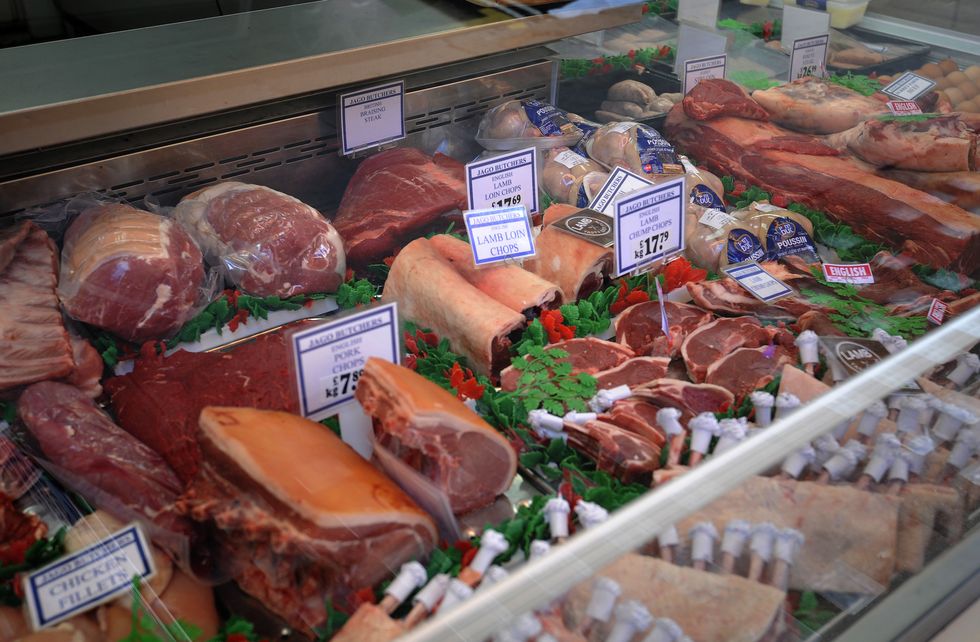Adam Chapman
Guest Reporter
A shocking graph forecasts dramatic price increases as farmers reportedly plan to block supermarket distribution centres with tractors in the New Year.
The escalation is in response to the Government's decision, announced by Chancellor Rachel Reeves in her first Budget, to impose a 20 per cent inheritance tax on farmers' assets valued over £1million, which previously enjoyed tax breaks designed to facilitate the transfer of family farms across generations.
Thousands of farmers and hundreds of tractors descended on Westminster following the announcement, putting pressure on the Government to reverse course.
However, Sir Keir Starmer refuses to back down, arguing that slapping 20 per cent death duties on farmers’ assets over £1million was a "fair and balanced" approach to fill the £22billion black hole left by the last government.
The Chancellor has also made it clear that her party will not change course, stating that the policy "was necessary to take tough decisions at the Budget and the spending review and those decisions remain. But our commitment to farmers is steadfast and our message to farmers is clear, that is why we provided £5billion to the farming budget over two years including more money than ever for sustainable food production".
Farmers have signalled that they will not back down either. Radical factions within farmers' protest groups are coordinating to block supermarket distribution centres with tractors in the New Year, the Daily Telegraph reported.
This strategy aims to disrupt the supply chain, potentially leading to empty supermarket shelves, panic buying and dramatic price hikes.

"The first time will be for a short period to show it can be done. Then a 12 or 24-hour shutdown, and ultimately if it gets that far, a complete shutdown until the Government come to the table," one insider told the Telegraph, adding that these measures could take effect as soon as mid-January.
"It could ultimately shut down the economy, no food means serious chaos. The Government have picked a fight with the wrong sector," they added.
How expensive could food get?
The precise extent of price increases would depend on the blockade's duration, government intervention, and the ability of supermarkets to source alternatives.
Drawing on historical precedents, such as the fuel protest in 2000, the shelf life of different foods and supply chain dynamics, we estimate below just how much Britons can expect to pay.

The graph above illustrates the estimated price increases for various food categories due to a complete blockade by UK farmers. The blue bars represent the lower bounds of the price increases, while the orange bars show the upper bounds.
Perishable goods such as meat, fruit, vegetables and dairy would experience the most immediate and dramatic price increases due to their short shelf lives and dependence on just-in-time delivery.
Broken down by category:
Staples, such as bread, rice, pasta and flour, could see slower initial price increases, as inventories in stores and warehouses cushion immediate shortages. However, prices would rise significantly over time as stocks deplete.
Broken down by category:
LATEST MEMBERSHIP DEVELOPMENTS

Items like canned goods, ready meals, and snacks may see slower price increases initially, as manufacturers might draw on existing stocks. However, longer disruptions could cause significant hikes due to ingredient shortages.
Broken down by category:
Broken down by category:
However, the broader economic impact could be significant, especially if the blockade leads to a "complete shutdown", as suggested.
Supermarkets are a major part of the retail sector, and a prolonged disruption could affect employment, economic activity, and even the stability of food prices.
Find Out More...
The escalation is in response to the Government's decision, announced by Chancellor Rachel Reeves in her first Budget, to impose a 20 per cent inheritance tax on farmers' assets valued over £1million, which previously enjoyed tax breaks designed to facilitate the transfer of family farms across generations.
Thousands of farmers and hundreds of tractors descended on Westminster following the announcement, putting pressure on the Government to reverse course.
However, Sir Keir Starmer refuses to back down, arguing that slapping 20 per cent death duties on farmers’ assets over £1million was a "fair and balanced" approach to fill the £22billion black hole left by the last government.
The Chancellor has also made it clear that her party will not change course, stating that the policy "was necessary to take tough decisions at the Budget and the spending review and those decisions remain. But our commitment to farmers is steadfast and our message to farmers is clear, that is why we provided £5billion to the farming budget over two years including more money than ever for sustainable food production".
Farmers have signalled that they will not back down either. Radical factions within farmers' protest groups are coordinating to block supermarket distribution centres with tractors in the New Year, the Daily Telegraph reported.
This strategy aims to disrupt the supply chain, potentially leading to empty supermarket shelves, panic buying and dramatic price hikes.

"The first time will be for a short period to show it can be done. Then a 12 or 24-hour shutdown, and ultimately if it gets that far, a complete shutdown until the Government come to the table," one insider told the Telegraph, adding that these measures could take effect as soon as mid-January.
"It could ultimately shut down the economy, no food means serious chaos. The Government have picked a fight with the wrong sector," they added.
How expensive could food get?
The precise extent of price increases would depend on the blockade's duration, government intervention, and the ability of supermarkets to source alternatives.
Drawing on historical precedents, such as the fuel protest in 2000, the shelf life of different foods and supply chain dynamics, we estimate below just how much Britons can expect to pay.
Highest to lowest price increases

The graph above illustrates the estimated price increases for various food categories due to a complete blockade by UK farmers. The blue bars represent the lower bounds of the price increases, while the orange bars show the upper bounds.
Perishable goods such as meat, fruit, vegetables and dairy would experience the most immediate and dramatic price increases due to their short shelf lives and dependence on just-in-time delivery.
Broken down by category:
- Fruits and Vegetables: Prices could double within days if distribution halts completely. During the early 2023 shortages in the UK, vegetable prices rose by 30–50 per cent in just a few weeks due to limited supply.
- Dairy Products: Milk, butter, and cheese could see price increases of 40–70 per cent if dairy farms cannot distribute products.
- Meat: Prices for fresh meats might rise by 50–100 per cent within weeks, depending on the availability of frozen reserves.
Staples, such as bread, rice, pasta and flour, could see slower initial price increases, as inventories in stores and warehouses cushion immediate shortages. However, prices would rise significantly over time as stocks deplete.
Broken down by category:
- Bread and Flour: Prices could rise by 20–40 per cent within a month. Wheat supply chains rely heavily on domestic logistics, making them vulnerable.
- Pasta and Rice: These products are often imported, but disruption at ports (linked to farmer blockades) could cause a 15–30 per cent increase in prices.
LATEST MEMBERSHIP DEVELOPMENTS
- Britain is fighting for its survival and the greatest threat is found in our homes - Rael Braverman
- MPs’ security costs rise staggering 15,000 per cent in 15 years as threats and intimidation increase
- Patrick Christys and Emily Carver on why the GB News family is so important in Members Q&A

Items like canned goods, ready meals, and snacks may see slower price increases initially, as manufacturers might draw on existing stocks. However, longer disruptions could cause significant hikes due to ingredient shortages.
Broken down by category:
- Canned Foods: Price increases of 10–20 per cent within the first few weeks, potentially rising to 30–40 per cent for highly demanded items.
- Ready Meals and Snacks: Costs may rise by 15–25 per cent, reflecting both ingredient and packaging shortages.
Broken down by category:
- Coffee and Spices: Prices could rise by 10–15 per cent due to increased logistical costs.
- Tropical Fruits: Bananas, mangoes, and avocados could see a 20–30 per cent price increase if ports are affected.
However, the broader economic impact could be significant, especially if the blockade leads to a "complete shutdown", as suggested.
Supermarkets are a major part of the retail sector, and a prolonged disruption could affect employment, economic activity, and even the stability of food prices.
Find Out More...
